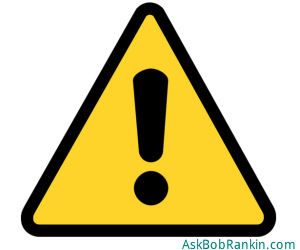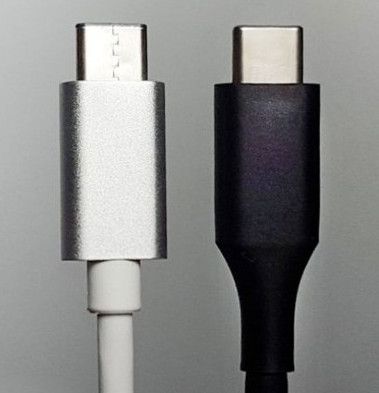The new USB-C plug and port standard may be the biggest little thing to hit the tech world this century. Finally, there is a truly universal cable that can connect all of our devices - desktop computers, laptops, tablets, phones, monitors, and things haven't been invented yet. But if you buy the wrong USB-C cable, it may destroy your expensive gadgets! Read on to learn what kind of USB-C cables to avoid and how to recognize them...
AskBob - [ZAP!] Don't Buy the Wrong USB-C Cable - February 9, 2016
[ZAP!] Don't Buy the Wrong USB-C Cable
USB-C is a Good Thing, But...
Apple and Google were first to release laptops that support USB-C. Now it's showing up everywhere, for good reasons. USB-C can deliver power and data much faster and in larger quantities than its predecessors.
More importantly to most users, though, the plug is reversible. No more frustrating attempts to get it “right side up!†USB-C is also backwards-compatible with earlier USB ports and plugs, an important consideration as the industry makes the transition to the USB-C standard.
But transition comes with a lot of chaos, as cable makers scramble to grab USB-C market share and buyers are still uncertain what a "good" USB-C cable looks like. Some cable makers have flooded the market with cheap USB-C cables that cut corners dangerously, resulting in instant death for the laptops and other devices into which they are plugged.

It happened to Google engineer Benson Leung while he was testing USB-C cables. He plugged a cheap cable into his Chromebook Pixel and ZAP! The USB test equipment and the ports on Leung's Chromebook were instantly and permanently destroyed by a power overload.
The same thing happened to Dieter Bohn's Macbook Air. The reviewer for The Verge bought a few inexpensive USB-C cables on Amazon and used one to charge his Nexus 6 phone using the Macbook Air's power; the cable drew too much power from the laptop. Apple's excellent surge protection shut down the Macbook Air's USB ports instantly, but even after rebooting Bohn says the ports now work only "intermittently."
Leung reports in his Amazon review of the cable, "it appears that they (Surjtech) completely miswired the cable. The GND pin on the Type-A plug is tied to the Vbus pins on the Type-C plug. The Vbus pin on the Type-A plug is tied to GND on the Type-C plug. "This is a total recipe for disaster and I have 3 pieces of electronics dead to show for it, my Pixel 2015, and two USB PD analyzers."
So, scratch any USB-C cables made by Surjtech from your shopping list. But few of us have the test equipment that Leung used to diagnose the miswiring. Luckily, there are a few telltale signs of shoddy construction that can help ordinary mortals avoid buying a nightmare cable.
Which USB-C Cables Are Safe to Buy?

Look at the USB-C plugs shown in the image here. The one on the right is seamless; it was made using a relatively expensive "deep extruding" method of metal-forming. The one on the left shows a zigzag seam, indicative of metal that was merely folded into a tube shape and sloppily secured. The critical wiring inside is likely to be just as sloppy.
Also look for a USB-C cable that is certified by the USB Implementers Forum, the nonprofit coalition of companies that developed the USB standard. The USB-IF maintains a list of certified USB-C cable products and updates it weekly; the current list has 61 products on it.
The difference in price between a quality USB-C cable and one that may destroy your hardware is trivial. For instance, TechMatte's certified USB-C to USB-A cable costs only $4.99 for a one-footer, and six feet will run just $7.99.
Keep your eye on build quality and USB-IF certification, not on the price tag of a USB-C cable. This is a spectacular example of when not to be penny-wise and pound-foolish.
AskBob - [ZAP!] Don't Buy the Wrong USB-C Cable - February 9, 2016
[ZAP!] Don't Buy the Wrong USB-C Cable
USB-C is a Good Thing, But...
Apple and Google were first to release laptops that support USB-C. Now it's showing up everywhere, for good reasons. USB-C can deliver power and data much faster and in larger quantities than its predecessors.
More importantly to most users, though, the plug is reversible. No more frustrating attempts to get it “right side up!†USB-C is also backwards-compatible with earlier USB ports and plugs, an important consideration as the industry makes the transition to the USB-C standard.
But transition comes with a lot of chaos, as cable makers scramble to grab USB-C market share and buyers are still uncertain what a "good" USB-C cable looks like. Some cable makers have flooded the market with cheap USB-C cables that cut corners dangerously, resulting in instant death for the laptops and other devices into which they are plugged.

It happened to Google engineer Benson Leung while he was testing USB-C cables. He plugged a cheap cable into his Chromebook Pixel and ZAP! The USB test equipment and the ports on Leung's Chromebook were instantly and permanently destroyed by a power overload.
The same thing happened to Dieter Bohn's Macbook Air. The reviewer for The Verge bought a few inexpensive USB-C cables on Amazon and used one to charge his Nexus 6 phone using the Macbook Air's power; the cable drew too much power from the laptop. Apple's excellent surge protection shut down the Macbook Air's USB ports instantly, but even after rebooting Bohn says the ports now work only "intermittently."
Leung reports in his Amazon review of the cable, "it appears that they (Surjtech) completely miswired the cable. The GND pin on the Type-A plug is tied to the Vbus pins on the Type-C plug. The Vbus pin on the Type-A plug is tied to GND on the Type-C plug. "This is a total recipe for disaster and I have 3 pieces of electronics dead to show for it, my Pixel 2015, and two USB PD analyzers."
So, scratch any USB-C cables made by Surjtech from your shopping list. But few of us have the test equipment that Leung used to diagnose the miswiring. Luckily, there are a few telltale signs of shoddy construction that can help ordinary mortals avoid buying a nightmare cable.
Which USB-C Cables Are Safe to Buy?

Look at the USB-C plugs shown in the image here. The one on the right is seamless; it was made using a relatively expensive "deep extruding" method of metal-forming. The one on the left shows a zigzag seam, indicative of metal that was merely folded into a tube shape and sloppily secured. The critical wiring inside is likely to be just as sloppy.
Also look for a USB-C cable that is certified by the USB Implementers Forum, the nonprofit coalition of companies that developed the USB standard. The USB-IF maintains a list of certified USB-C cable products and updates it weekly; the current list has 61 products on it.
The difference in price between a quality USB-C cable and one that may destroy your hardware is trivial. For instance, TechMatte's certified USB-C to USB-A cable costs only $4.99 for a one-footer, and six feet will run just $7.99.
Keep your eye on build quality and USB-IF certification, not on the price tag of a USB-C cable. This is a spectacular example of when not to be penny-wise and pound-foolish.
